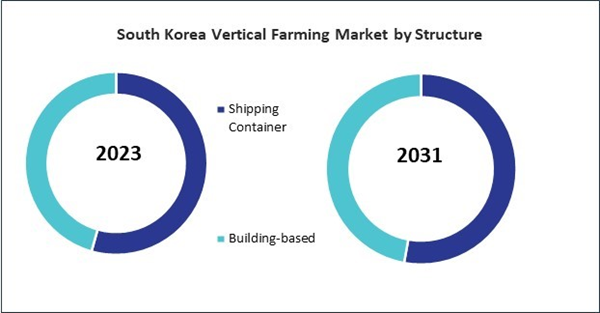The Asia Pacific Vertical Farming Market is expected to witness market growth of 20.2% CAGR during the forecast period (2024-2031).
The China market dominated the Asia Pacific Vertical Farming Market by country in 2023, and is expected to continue to be a dominant market till 2031; thereby, achieving a market value of $2.25 billion by 2031. The Japan market is registering a CAGR of 19.6% during 2024-2031. Additionally, the India market is expected to showcase a CAGR of 21% during 2024-2031.
The vertical farming market has emerged as a transformative force in modern agriculture, redefining how food is grown, distributed, and consumed in an increasingly urbanized and resource-constrained world. Vertical farming refers to cultivating crops in stacked layers or vertically inclined surfaces, often within controlled indoor environments such as warehouses, skyscrapers, or shipping containers. By leveraging advanced technologies like hydroponics, aeroponics, and artificial lighting, vertical farming optimizes space, reduces water usage, and minimizes the environmental footprint of traditional agriculture.
Moreover, vertical farming’s versatility makes it applicable across various contexts, from urban centers to remote regions. One of its primary applications is food production, particularly for high-demand crops such as leafy greens, herbs, strawberries, and microgreens. These crops thrive in controlled environments, where temperature, humidity, and nutrient levels can be precisely managed to maximize yield and quality. Beyond fresh produce, vertical farming is increasingly being explored for cultivating specialty crops like medicinal plants, including cannabis, which require stringent growing conditions that indoor systems can reliably provide.
The market is expanding rapidly as countries worldwide seek innovative solutions for sustainable food production. Factors such as government incentives, increasing urbanization, and advancements in protected cropping are shaping the future of vertical farming. India, China, and Australia are witnessing significant developments in this sector, driven by policy support, demographic shifts, and technological advancements. These factors foster growth in the market, improve food security, and optimize resource utilization.
The China market dominated the Asia Pacific Vertical Farming Market by country in 2023, and is expected to continue to be a dominant market till 2031; thereby, achieving a market value of $2.25 billion by 2031. The Japan market is registering a CAGR of 19.6% during 2024-2031. Additionally, the India market is expected to showcase a CAGR of 21% during 2024-2031.
The vertical farming market has emerged as a transformative force in modern agriculture, redefining how food is grown, distributed, and consumed in an increasingly urbanized and resource-constrained world. Vertical farming refers to cultivating crops in stacked layers or vertically inclined surfaces, often within controlled indoor environments such as warehouses, skyscrapers, or shipping containers. By leveraging advanced technologies like hydroponics, aeroponics, and artificial lighting, vertical farming optimizes space, reduces water usage, and minimizes the environmental footprint of traditional agriculture.
Moreover, vertical farming’s versatility makes it applicable across various contexts, from urban centers to remote regions. One of its primary applications is food production, particularly for high-demand crops such as leafy greens, herbs, strawberries, and microgreens. These crops thrive in controlled environments, where temperature, humidity, and nutrient levels can be precisely managed to maximize yield and quality. Beyond fresh produce, vertical farming is increasingly being explored for cultivating specialty crops like medicinal plants, including cannabis, which require stringent growing conditions that indoor systems can reliably provide.
The market is expanding rapidly as countries worldwide seek innovative solutions for sustainable food production. Factors such as government incentives, increasing urbanization, and advancements in protected cropping are shaping the future of vertical farming. India, China, and Australia are witnessing significant developments in this sector, driven by policy support, demographic shifts, and technological advancements. These factors foster growth in the market, improve food security, and optimize resource utilization.
List of Key Companies Profiled
- AeroFarms, LLC
- American Hydroponics
- BrightFarms, Inc. (Cox Enterprises Inc.)
- Plenty Foods Pty Ltd. (Josh Gadischke)
- Bowery Farming, Inc.
- Eden Green Technology
- Lindsay Corporation
- Hunter Industries, Inc.
- The Toro Company
- Valmont Industries, Inc.
Market Report Segmentation
By Component
- Hardware
- Lighting
- Hydroponic Components
- Climate Control & Sensors
- Software
- Services
By Category
- Fruits Vegetables, & Herbs
- Flowers & Ornamentals
- Other Category
By Mechanism
- Hydroponics
- Aeroponics
- Aquaponics
By Structure
- Shipping Container
- Building-based
By Country
- China
- Japan
- India
- South Korea
- Singapore
- Malaysia
- Rest of Asia Pacific
Table of Contents
Chapter 1. Market Scope & Methodology
Chapter 2. Market at a Glance
Chapter 3. Market Overview
Chapter 4. Asia Pacific Vertical Farming Market by Component
Chapter 5. Asia Pacific Vertical Farming Market by Category
Chapter 6. Asia Pacific Vertical Farming Market by Mechanism
Chapter 7. Asia Pacific Vertical Farming Market by Structure
Chapter 8. Asia Pacific Vertical Farming Market by Country
Chapter 9. Company Profiles
Companies Mentioned
- AeroFarms, LLC
- American Hydroponics
- BrightFarms, Inc. (Cox Enterprises Inc.)
- Plenty Foods Pty Ltd. (Josh Gadischke)
- Bowery Farming, Inc.
- Eden Green Technology
- Lindsay Corporation
- Hunter Industries, Inc.
- The Toro Company
- Valmont Industries, Inc.
Methodology

LOADING...









